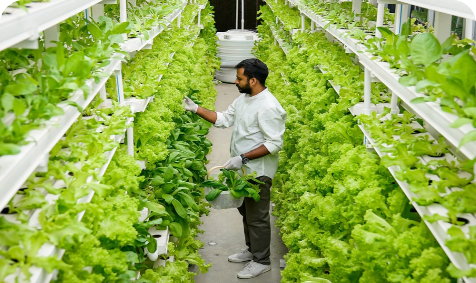
The What and Why of Hydroponic Farming?
What is hydroponics? How does it work? How is hydroponic farming different from traditional farming?
When we tell people that we grow our produce using hydroponics, we usually get this type of response.
“Sounds cool… is it something to do with healthy food maybe?”
For all the hydro-curious folks out there, we’ve curated a primer on the basics of hydroponic farming.
What is Hydroponics?
Hydroponics is a way to skip the soil, sub in a different material to support the roots of the plant, and grow crops directly in nutrient-rich water.
There are multiple approaches to designing hydroponic systems, but the core elements are the same.
Requirements for hydroponics farming?
1. Freshwater: Most plants like water with a pH level of around 6–6.5. You can adjust the acidity of your water with over-the-counter solutions found at your local hardware or hydroponic store.
2. Oxygen: In traditional farming, roots can get the oxygen needed for respiration from the soil. Depending on your hydroponic setup, you will either need to leave space between the base of your plant and the water reservoir, or you’ll need to oxygenate your container (think of bubbles in a fish tank), which you can accomplish by buying an air stone or installing an air pump within your setup.
3. Root Support: Even though you don’t need soil, your plant’s roots still require a little something to hold on to. Typical materials include vermiculite, perlite, peat moss, coconut fiber, and rockwool. Stay away from materials that might compact (like sand) or that don’t retain any moisture (like gravel).
4. Nutrients: The plant needs plenty of magnesium, phosphorus, calcium, and other nutrients to stay healthy and productive. Just like plants growing in the ground need healthy soil and fertilizer. When you’re growing plants without soil, this so-called “plant food” must be included in the water that’s feeding your plants.
5. Light: If you’re planning to grow your plants indoors, then you have to invest in some special lighting for the plants. Each kind of plant will have a different requirement for the amount of light it needs and for the placement of lights.
While there are other elements to consider as you increase the sophistication of your hydroponic farm (for instance, things like CO2 supplementation), the five listed above are the most fundamental elements of any hydroponic system.
By monitoring and adjusting these key variables, you can begin to discover precisely what your plants need to thrive and replicate those conditions for every growth in the future.
Why Do We Grow Plants Without Soil?
This subtle shift in how we grow plants is actually revolutionary, it allows growers to produce food anywhere in this world, at any time of the year, and to net higher yields with lesser resources.
Grow Anywhere and Anytime
Growing seasons and regions play a vital role in plantations as temperatures change and growing conditions change along with them. Even in “normal” conditions, there are plenty of places where the ground just isn’t conducive for farming (like deserts, concrete jungles, etc).
Using hydroponics, we can create hyper-local food systems. Our container farms are set upright in the communities and regions that we serve. It’s even possible to put a farm directly behind restaurants that want fresh veggies. And when you’re growing hydroponically, you don’t have to hit pause for a season or risk crop loss from inclement weather.
Higher Yields
Plants grown in well-managed hydroponic systems are living the good life. Since roots are bathed in all the nutrients they need, plants spend more time growing upward and less time and energy growing extensive root systems to search for food.
Less Resources More Growth
Hydroponic systems use less water than traditional farming. This is because closed systems aren’t subject to the same rates of evaporation Also, the water used in hydroponic systems can be filtered, re-populated with nutrients, and fed back to plants again so that water is constantly being recycled instead of wasted!
Other “resources” indoor hydroponic plants don’t need? Pesticides and other potentially harmful chemicals, since the hydro crops are protected from many of the pests and plant diseases found outdoors in soil-based farms.
Easy Troubleshooting
With a hydroponic system, you know exactly what conditions your plants are being grown in. As such, you can easily isolate variables and experiment! Once you find the perfect formula of light, pH balance, and nutrients, you can replicate success without always getting hit with curveballs.